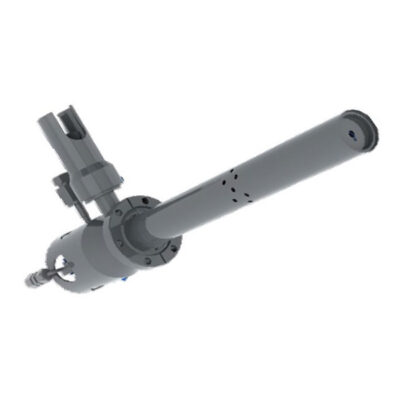HAT – Atomic Hydrogen Thermal Cracker
Details
- Cost effective solution for substrate cleaning & preparation
- Promotes 2D epitaxial growth (surfactant effect)
- Generation of atomically flat SiC surface, selective epi growth in patterned GaAs MBE, improved GaN growth rate,…
Presentation
The HAT is a cost-effective atomic Hydrogen source. This source generates flux of atomic hydrogen through high temperature thermal cracking of molecular hydrogen (H2) with a hot tungsten filament.
A flux of atomic hydrogen converts carbon and oxygen-based contaminants on substrate surfaces into volatile species which evaporate readily at relatively low temperature. Hence an atomic hydrogen source is very helpful for in situ, low temperature cleaning of substrate, deoxidization, etc.
It is also suggested that the growth rate in Ga-rich deposition of GaN is considerably enhanced under atomic hydrogen.
The dissociation efficiency is strongly dependent on the H2 pressure in the cracker zone and the filament temperature. Atoms of Hydrogen are produced by thermal cracking of high purity H2 gas. The source working temperature is around 2200°C.
All models are equipped with a water-cooling system to regulate the flange temperature.
HAT does not provide equivalent number of atomic species than with a plasma source, hence also releasing uncracked H2 in the growth chamber, but it’s a cost-effective technology to make atomic hydrogen available, whether it is for substrate cleaning or preparation, or to modify the growth atmosphere and favor growth rate in certain applications
Cracking efficiency
Cracking efficiency has been measured using a quadruple mass spectrometer by measuring the decreasing of H2 partial pressure in the test chamber at a H2 flow of 0,1 sccm. The source was installed in horizontal position. The graph can be seen on the right.
Current/voltage and corresponding temperatures
The filament temperature has been determined by physical resistivity measurement using calibration data from J.A. Jones, Phys. Rev., 28 (1926). Note that those values may slightly vary, depending on your measurement system and on filament./source aging.
Layout
Technical information
| Characteristics | HAT |
|---|---|
| Filament | Single tungsten wire |
| Filament design | Self supported |
| Mounting flange | CF35 |
| Thermocouple | C-type |
| Power consumption | 56 W |
| Water-cooling | Yes |
| Typical operating temperature | 2300°C |
| Maximum Output temperature | 2600°C |
| Max outgassing temperature | 2800°C |
| Gas inlet fitting | ¼ VCR – F |









